-
Membership
Membership
Anyone with an interest in the history of the built environment is welcome to join the Society of Architectural Historians -
Conferences
Conferences
SAH Annual International Conferences bring members together for scholarly exchange and networking -
Publications
Publications
Through print and digital publications, SAH documents the history of the built environment and disseminates scholarship -
Programs
Programs
SAH promotes meaningful engagement with the history of the built environment through its programsMember Programs
-
Jobs & Opportunities
Jobs & Opportunities
SAH provides resources, fellowships, and grants to help further your career and professional life -
Support
Support
We invite you to support the educational mission of SAH by making a gift, becoming a member, or volunteering -
About
About
SAH promotes the study, interpretation, and conservation of the built environment worldwide for the benefit of all
The Revitalized and the Neglected: Rapp and Rapp's Movie Palaces in Chicago
C H I C A G O
The red and yellow neon letters of this instantly recognizable marquee sign that brighten up the corner of State and Lake are one of the defining landmarks of the city’s nightscape – immortalized on the posters for the popular musical film Chicago (2002). The masterminds behind this Chicago emblem were Cornelius W. (1861-1927) and George L. (1878-1924) Rapp who established their own successful architectural firm Rapp and Rapp. Trained at the University of Illinois School of Architecture, the brother-duo designed several hundreds movie palaces throughout the country in the early twentieth century. By teaming up with the Balaban and Katz theater chain – the forerunner of today’s Paramount Pictures – the brothers constructed their most famous works in Chicago.
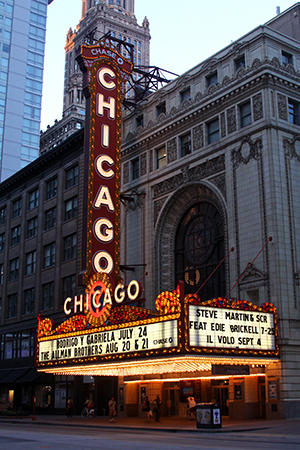
Rapp and Rapp’s theaters reflect the rapidly changing forms of the movie-going experience in the twentieth century – not only in their initial designs but also, and perhaps more significantly, in what is done with these buildings after their inaugural years. The exhibition of films originated in vaudeville houses, with the earliest films – which were only ten to fifteen minutes long – being shown as one of the vaudeville acts. The present-day Bank of America Theatre (1906), which was designed by Edmund R. Krause aided by the young C. W. and George L. Rapp, was initially a vaudeville house. The theater joined the Orpheum Circuit in the 1920s and later began screening movies in the early 1930s. The Bryn Mawr Theatre (1914) also originally operated as a vaudeville theater, switching to functioning as a nickelodeon, a small storefront theater charging a nickel for admissions, in its later years before closing in the 1980s. This modest two-story building which was built right next to the Bryn Mawr Stop of the elevated L tracks on the Red Line has surprisingly survived, currently being utilized as a retail store and storage space.
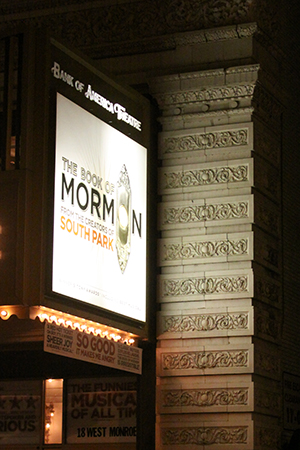
-is-now-a-popular-concert-venue-in-the-north-side-of-chicago-.jpg?sfvrsn=96e8f2aa_2)
With the advent of the feature film and innovations in sound cinema, bigger auditoriums were necessary to accommodate larger audiences – thus ushering in the era of grand movie palaces. The theaters boasted of excessive ornamentation and utilized motifs of the royal palace, the Exotic, and the Atmospheric in order to fill the audience with awe and wonder.
Rapp & Rapp’s theaters featured designs that relied heavily on historical references to the Old World. The Chicago Theatre (1921) – the flagship of the Balaban & Katz chain, the State-Lake Theatre (1919) and Cadillac Palace Theatre (1926) of the Orpheum Circuit, as well as the Riviera Theatre (1918) in the North Side Uptown neighborhood all recall the lavishly ornate designs of the French Baroque style inspired by the Palace of Versailles. Gold leaf ornamentation, crystal chandeliers, rose marbled walls, towering columns, and successions of lobbies and foyers characterized the interior of these theaters. Another prominent Old World style was the Spanish Revival that characterizes the Central Park Theatre (1917) and the Uptown Theatre (1925) of the western and northern neighborhoods, respectively. Despite these overt architectural references to the European royalty, it is interesting to note that the architects' philosophy included the democratization of the theater-going activity. George Rapp said of one of his theaters, “Here is a shrine to democracy where the wealthy rub elbows with the poor.”
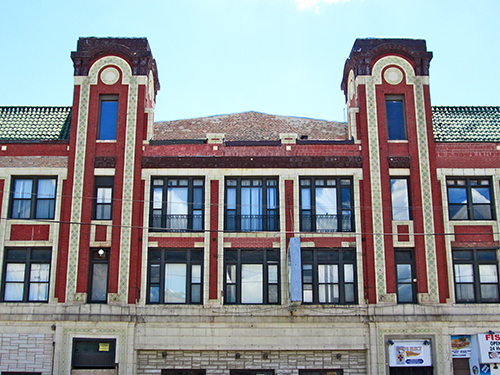
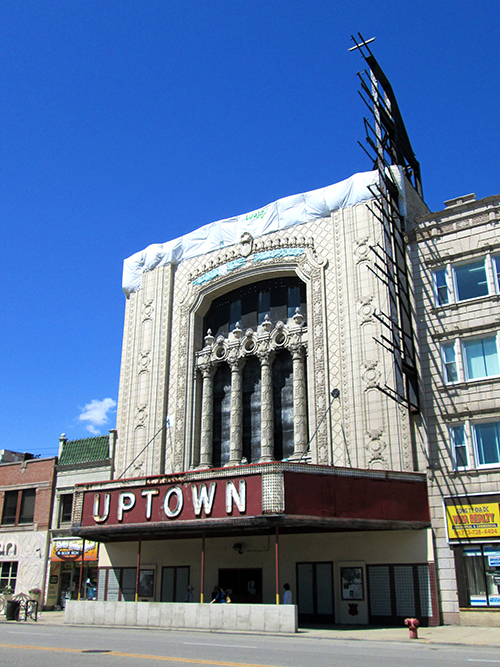
The Oriental Theatre (1926), now called the Ford Center for the Performing Arts Oriental Theater, is an example of theaters that drew on exoticised motifs in order to satiate the cultural hunger for styles of faraway lands. Inspired by the architecture of India and the Far East, lights consisted of elephant heads with tusks, the walls were adorned with soft silk and regal velvets, and the ceiling was garishly decorated with plasterwork elephants and other exotic beasts.
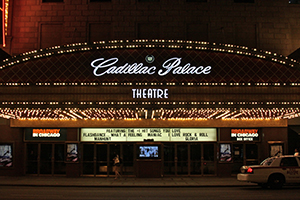
Another popular architectural style that characterized movie palaces was the Atmospheric. Instead of decorating the ceiling with the standard ornate dome, the plaster ceiling of the Gateway Theatre (1930) was left bare, resembling an Italian outdoor garden complete with twinkling stars and floating clouds. The open-air illusion reinforced the fantasy world that the architects wanted to create for the theater patrons.
What the architects wanted to provide for the audience was an all-encompassing experience by creating a total environment. The original architectural drawings and floor plans held at the Chicago History Museum reveals the elaborate designs with which the imaginative architects decorated every corner of these movie palaces. What they had in mind was the experience of the moviegoers, carefully planning out the path that they would take as they first came upon the theater's facade, through the doors into the ticket lobby, then into the grand lobby and up the grand staircase, and past the ushers into their seats where they would be able to gaze up to the high ornate ceilings of the auditorium. The minutest details of ladies' powder rooms and gentlemens’ smoking rooms to the water fountains and grills for the air conditioning vents were deliberated upon and lavishly decorated accordingly.
With the introduction of personal television sets that brought entertainment for the masses into the home and the burgeoning growth of cinema complexes at the suburban mall, movie palaces experienced a decline of theatergoers in the 1950s. Many of Rapp and Rapp’s theaters were closed and razed in the 1970s and 1980s. Luckily, the theaters standing in the Loop have been able to go through major renovations costing hundreds of millions of dollars, due to Mayor Richard M. Daley’s revitalization efforts in developing the North Loop Theater District in the last decades of the twentieth century. Today, Rapp & Rapp theaters downtown are still bustling hubs of entertainment with the capability of drawing in crowds from around the world for the performing arts (save for the State-Lake whose interior was gutted and converted into studios and offices for the ABC network in 1985).
-renamed-to-the-copernicus-cultural-and-civic-center-is-today-a-place-for-community-gatherings-of-the-polish-american-population-in-jefferson-park-chicago-.jpg?sfvrsn=d005343_2)
The extant theaters in the Northern and Western neighborhoods have been, however, in varying states of disrepair. Even the Riviera Theatre, which is now a popular concert venue, is covered up with a white tarp across the top arches of its facade. Just down the street, the Uptown Theatre, which has gone through an unfortunate series of failed efforts of renovation, sits frozen in time with its windows and doors boarded up, the marquee baring its rusted metal grating, and its once beautiful arches covered up by a tarp. The huge spaces inside these buildings have, however, given specific communities in Chicago a place for communal gatherings. The Central Park Theatre, although it had lost the glitzy shine of its better days, was purchased by the House of Prayer, Church of God in Christ in 1971 and has since been used for congregations. The Gateway Theatre, now called the Copernicus Center, was acquired by the Polish-American Congress in 1985 and subsequently restored as a place for community gatherings for the huge Polish population in Chicago.
In the next several years, Rapp and Rapp's theaters will celebrate their hundred-year anniversaries. The active theaters in the Loop will undoubtedly take advantage of this milestone with celebratory events, but it will be important to keep an eye out for the next steps for these neglected theaters in the Northern and Western neighborhoods which have enormous architectural and historical value for the city of Chicago.
Christine Shang-Oak Lee is a 2013 Jeff Metcalf Fellow at the Society of Architectural Historians, and a fourth-year undergraduate at the University of Chicago studying art history. She is currently researching Western-style architecture in Korea built during its colonial period. On campus, you can find her in the projectionist booth with her hands tangled in old film reels at the student-run Doc Films, or drumming away infectious beats in the traditional Korean percussion group.
Use these photos for teaching or research! Hi-res versions of Christine's photos can be found in SAHARA: sah.org/sahara



Leave a commentOrder by
Newest on top Oldest on top